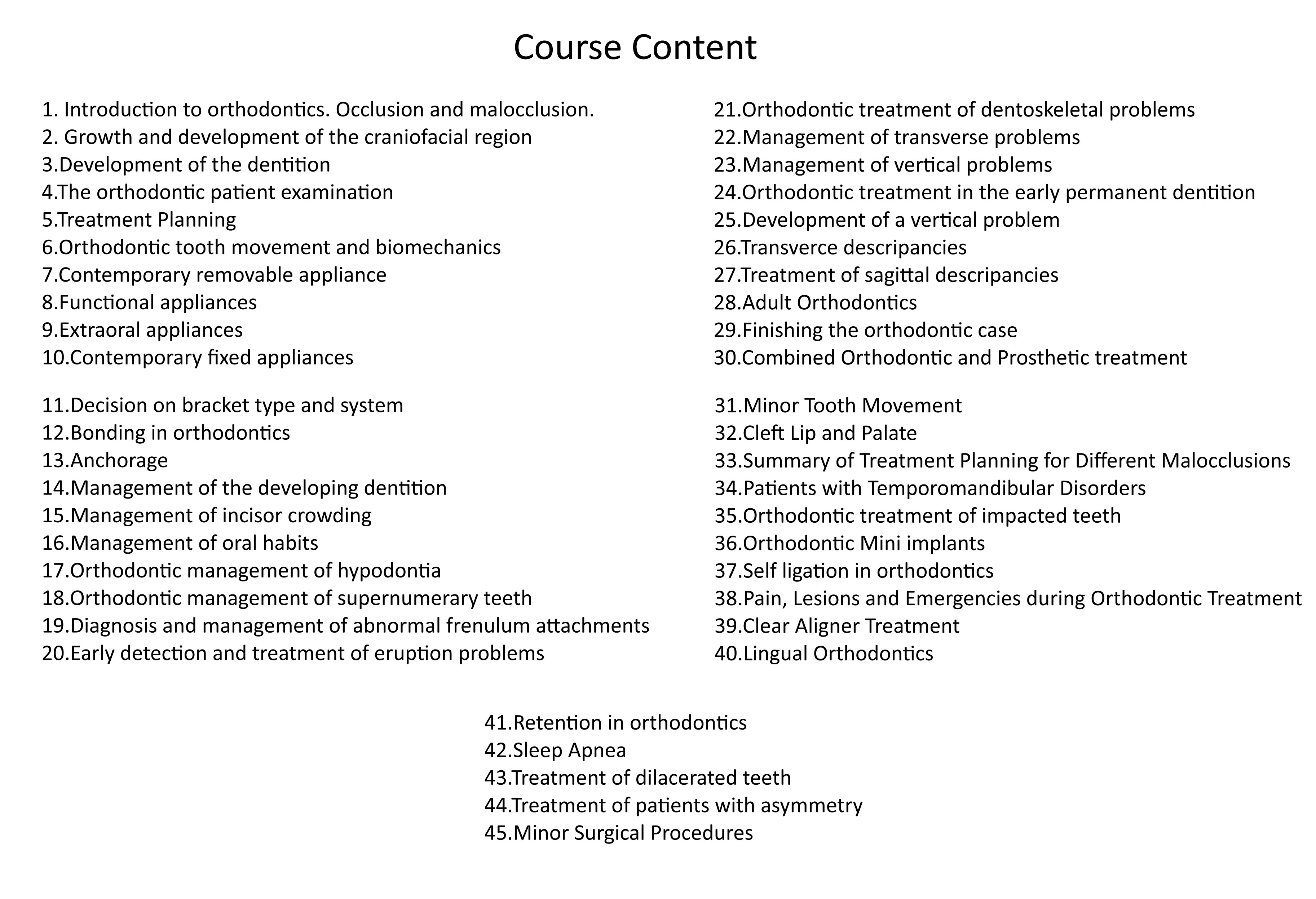Complete Orthodontic Course, from Beginner to Advanced (đang chờ dịch)
About the course
This complete orthodontic course explains in detail the fundamental principles of the discipline gathered in approximately 80 hours of lectures, video demonstrations, and clinical case presentations. By the end of the course, you will feel confident in planning and performing orthodontic treatment, starting from clinical examination and treatment planning, choosing the correct orthodontic appliance according to the case, and performing treatment with either fixed or removable appliances.
This detailed course will give you all the information to perform from simple to most complex treatment scheme including treatment with the help of temporary anchorage devices and combined surgical and orthodontic treatment of impacted teeth. You can see the full content of the course below.
If you join the course now, you will get lifetime access to all of the current 40+ orthodontic courses and all of the future courses. This website includes all of our courses in Udemy and you also get lectures that are not included in any of our courses in Udemy.

550.000 đ
Giáo viên: Dr. Ivelina Koycheva

19 học viên

3529 lượt xem

21 lượt mua
 Chia sẻ
Chia sẻ
 Mua khóa họcXem khóa học khác
Mua khóa họcXem khóa học khácNỘI DUNG BÀI HỌC
1.1 Introduction. Andrews six keys of normal occlusion. Positions of the mandible.
1.2 Classification of malocclusion. Benefits and risks of orthodontic treatment.
2.1 Growth and development of the craniofacial region
3.1 Development of the dentition
4.1 Medical and Dental history. Extraoral examination. Dental photography
4.2 Dental cast analysis. Analysis in the three planes of space
4.3 Cephalometric analysis. Steiner’s analysis. Wits appraisal. Tweed’s analysis
5.1 Aims of treatment. Facial aims. Occlusal aims
5.2 Space creation. Extraction.Transverse arch expansion. Reduction of tooth width
5.3 Step by step treatment plan. Planning treatment for moderate problems
5.4 Planning complex orthodontic treatment
5.5 Limiting factors of orthodontic treatment. Envelop of discrepancy
5.6 Timing of treatment depending on the malocclusion.mp4
6.1 Orthodontic tooth movement
6.2 Biomechanics of tooth movement. Introduction. Laws of Newton. Definitions
6.3 Types of dental movements
7.1 Clinical use and treatment with removable appliances
7.2 Functional appliances-characteristics. Removable appliances. Clear aligner therapy
8.1 Functional appliances- history, effects, advantages and limitations, indications
8.2 Appliances
8.3 Andersen activator
8.4 Bionator
8.5 Frankel appliance
8.6 Twin Block. Fixed functional appliances
9.1 Extraoral appliances
10.1 Advantages, limitations and components of the fixed appliances. Metal brackets
10.2 Plastic Brackets. Ceramic Brackets. First, second, third order bends
10.3 Parts of the bracket. Modification of slot dimension
10.4 Ligation of the brackets. Auxiliary features. Archwires. Fixed expansion arches
11.1 Evolution of treatment mechanics and contemporary appliance design
11.2 Roth Prescription
11.3 McLaughlin Bennett Trevisi (MBT) prescription
11.4 Alexander orthodontic philosophy
11.5 Damon system
12.1 Bonding Procedure. Tips on placing brackets in different cases
12.2 Treatment stages- Leveling and Aligning; Working Stage; Finishing Stage
13.1 Classification of anchorage. Indications for anchorage.
13.2 Types of anchorage. Minimal Anchorage.
13.3 Moderate Anchorage
13.4 Maximum or Severe Anchorage. Absolut Anchorage.
14.1 Space management in the transitional dentition. Planning for Space Management
14.2 Treatment Options for Space Management. Space maintenance
14.3 Space regaining. Fixed unilateral and bilateral regainers
14.4 Space creation. Space closure. Space supervision
15.1 Classification of incisor crowding. Treatment of minor and moderate crowding
15.2 Treatment of severe crowding. Serial extraction
16.1 Non-Nutritive Sucking. Thumb or Finger Sucking Treatment
16.2 Pacifier Habits. Tongue Thrust. Lip sucking or lip interposition habit
16.3 Mouth Breathing. Speech problems. Bruxism. Nail biting habit
17.1 Orthodontic management of hypodontia. Definitions. Etiology. Effects of hypodontia
17.2 Management of Missing Lateral Incisors
17.3 Management of Missing Mandibular Second Premolars
18.1 Orthodontic management of supernumerary teeth
19.1 Diagnosis and management of abnormal frenulum attachments
20.1 Phases of Tooth Eruption. Mechanisms of Eruptive Tooth Movement.
20.2 Transposition. Impaction
20.3 Ankylosis - Incidence, Etiology, Diagnosis, Treatment
21.1 Strategies of early treatment. Class II malocclusion.
21.2 Anterior Dental Crossbite and Class III Malocclusion
22.1 Management of transverse problems
23.1 Management of vertical problems. Open bite
23.2 Deep bite
24.1 Space Gaining Procedures Extraction. Interproximal Enamel Reduction
24.2 Treatment of Class I Malocclusions
25.1 Development of a vertical problem. Diagnosis of vertical discrepancies
25.2 Deep bite
25.3 Open bite
26.1 Development of crossbite. Types of posterior crossbites. Disjunction
26.2 Treatment for posterior crossbite
27.1 Treatment of sagittal discrepancies Class II malocclusion. Treatment planning
27.2 Maxillary distalization. Functional and Skeletal Class II
27.3 Extraction treatment. Skeletal Class II
27.4 Class III malocclusion
28.1 Potential Adult Orthodontic Patients. Diagnosis- Problem list
28.2 Aetiology of malocclusion. Interdisciplinary Versus Multidisciplinary Treatments
28.3 Anchorage. Material-related Adverse Reactions in Orthodontics
28.4 Orthodontic Treatment of Periodontally Involved Anterior Teeth
28.5 Interdisciplinary Collaboration Between Orthodontics and Periodontics
29.1 Finishing the orthodontic case
29.2 Debonding
30.1 Combined Orthodontic and Prosthetic treatment
31.1 Minor Tooth Movement
32.1 Definitions. Prenatal development of lip and palate. Classification. Etiology
32.2 Treatment
33.1 Management of Intra-Arch Problems
33.2 Management of Transverse Malocclusions
33.3 Management of Vertical Malocclusions. Deep Bite. Open Bite
33.4 Management of Sagittal Malocclusions
33.5 Class II Division 2 Malocclusion
33.6 Class III Malocclusion. Pseudo-Class III Malocclusion. Bimaxillary
34.1 Patient Examination. Classification of TMD. Joint disorders. Inflammatory condition
34.2 Masticatory muscle disorders. Intracranial and vascular pain disorders
34.3 Connection between malocclusion and TMD. Costen syndrome
35.1 Orthodontic treatment of impacted teeth. Diagnosis of impacted teeth
35.2 Orthodontic and radiographic assessment of impacted teeth. Preventive Treatment
35.3 Impacted Maxillary Canines. Diagnosis. Assessment. Interceptive treatment
35.4 Criteria for Choosing Orthodontic and Surgical Protocol. Surgical Approaches
35.5 Stages of Orthodontic Treatment
35.6 Labially impacted maxillary canines. Interceptive Treatment.Surgical uncovering
35.7 Palatally impacted canines. Surgical uncovering techniques. Impacted Canines
35.8 Impacted maxillary central incisors. Impacted premolars and mandibular molars
36.1 Skeletal anchorage. Stability. Specifications. Orthodontic loading
36.2. Insertion sites
36.3 Surgical procedures
36.4 Anterior–posterior treatment. Anterior retraction
36.5 Posterior distalization
36.6 Molar protraction
36.7 Vertical control. Anterior intrusion
36.8 Anterior extrusion
36.9 Maxillary transverse expansion
36.10 Posterior molar intrusion
36.11 Unilateral intrusion. Transverse correction of ectopic teeth
37.1 Evolution of Ligation and Appliances
37.2 The self ligating bracket. Active and passive systems
37.3 Properties of an Ideal Ligation System. Friction and Self ligation
37.4 Torque expression of self-ligating brackets.Treatment with self ligating bracket
37.5 Ligation of Archwires. Retention. Cost and Treatment Efficiency
38.1 Pain in orthodontics
38.2 Lesions and urgencies during orthodontic treatment
39.1 Introduction. Tooth movement biomechanics. Biomechanics with aligners
39.2 Attachments
39.3 Advantages and disadvantages of aligner treatment. Steps in aligner treatment
39.4 Treatment options. Resolving of crowding
39.5 Treatment of open bite, deep bite, crossbite. Space Closure. Class II Correction
40.1 Advantages and Disadvantages of Lingual Therapy
40.2 Bracket positioning. Laboratory Procedures. Indirect Bonding procedure
40.3 Archwire sequence. Instruments used in lingual orthodontics. Anchorage Control
40.4 Use of Quad Helix, Coil Springs and Elastics. Partial Canine Retraction
40.5 Correction of deep and open bite. Distalization Treatment. Finishing the case
41.1 Retention. Timing of Retention
41.2 Removable retainers. Fixed retainers
42.1 Signs and symptoms. Physical examination of the patient. OSA in children
42.1 Signs and symptoms. Physical examination of the patient. OSA in children
42.2 OSA in adults. Management. Questionnaire and treatment planning for OSA patient
43.1 Dilacerated teeth
43.2 Ankylosed teeth
43.3 Tooth transposition
44.1 Introduction. Classification of asymmetry. Etiology and diagnosis. Treatment
44.2 Correction of Unilateral Molar Rotation. Treatments
45.1 Minor Surgical Procedures
45.2 Orthognathic surgery. Diagnosis and treatment planning
45.3 Surgical procedures. Mandibular Surgery. Maxillary Surgery. Dentoalveolar Surgery

 Tải lên
Tải lên

